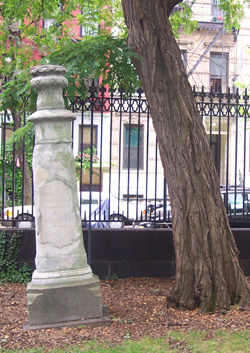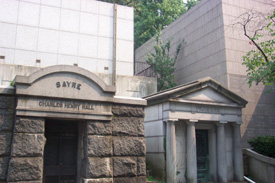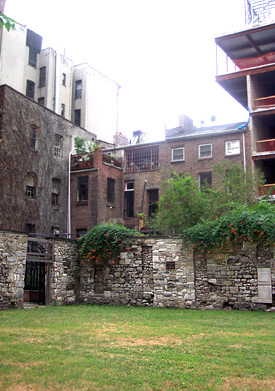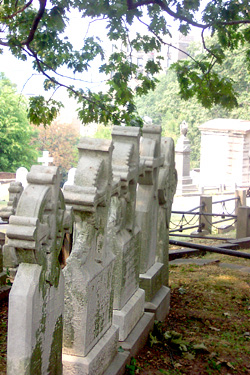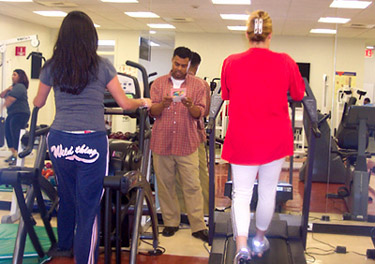Cemeteries: The End is Near
|
|
Following his death on July 4, 1831, and a glorious funeral procession through the streets of New York watched by as many as a hundred thousand people, United States President James Monroe became one of the first people to be buried in the brand new New York City Marble Cemetery on the Lower East Side, then a leafy, bucolic suburb on the northern fringe of New York City.
Thirty years later, Virginians reclaimed their native son, deeming the cemetery an insufficiently dignified place. By that time, the area was becoming the city's most crowded slum, and those from the fairer classes, living or dead, were fleeing.
The New York City Marble Cemetery still stands, on East 2nd Street, across from the Anthology Film Archives, near Urge bar and Anyway Cafe.
It might seem to have changed far less than the neighborhood around it, but in truth there are many parallels between the city's residences for the living and those for the dead. In Manhattan, burial space is even harder to find than an apartment. There is only one truly active graveyard in Manhattan - Trinity Church's cemetery in Washington Heights – and even there the only available space is in above ground "community mausoleums", large marble blocks that are, essentially, condos for corpses. Unhindered by rent regulations, the prices for graves have continued to rise. This has driven some who have spent a lifetime resisting the pull of the suburbs to wind up there posthumously.
Close to 325 graveyards have existed at some point during the city's history, according to Graveyard Shift: The Family Historian's Guide to New York City Cemeteries. Of these, the New York State Division of Cemeteries estimates that 75 are still accepting newcomers, mostly in Brooklyn or Queens. There is no reliable estimate for how many people get buried here each year, but given that the two largest cemeteries in the city -- Brooklyn's Green-Wood and Woodlawn in the Bronx -- bury only 3,000 people combined, there is little doubt that many of the 60,000 or so city residents that die annually end up beyond the city limits.
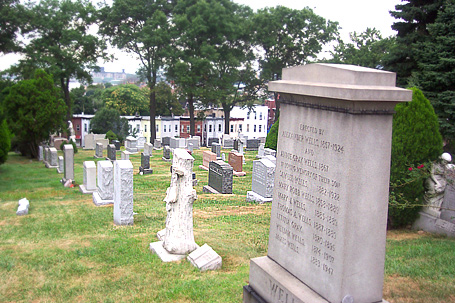
Green-Wood Cemetery
Still, city cemeteries are concerned that they will soon run out of space. When a graveyard fills up, it loses its primary means of income. Many fall into disrepair; some are abandoned completely. Many New Yorkers see cemeteries as not only places to bury the dead, but also as important green spaces and historical relics, and there are increasing efforts to preserve cemeteries or restore those in need.
For their part, all cemeteries are setting money aside to prepare for the day when they run out of space. Some are also looking for other ways to raise the money they need to mow their lawns and maintain their tombstones in perpetuity.
"When your entire annual budget is spent on a few hours gardening and general maintenance, you want to think creatively," said Colleen Iverson of the New York City Marble Cemetery. The cemetery, like others, solicits donations by promoting itself as a historical site through events like Open House New York (this year, four cemeteries are participating: New York City Marble Cemetery, nearby New York Marble Cemetery, Green-Wood and Woodlawn). Cemeteries are also encouraging engagement by throwing concerts (there is a concert this Thursday at the New York City Marble Cemetery), leading regular tours, holding cocktail parties, and even offering themselves out for weddings.
 Forty years ago, New York reacted to the loss of old Pennsylvania Station by passing a law to protect city landmarks. This series, in partnership with Open House New York, looks at the physical city since the birth of the preservation movement. |
New York City Marble Cemetery has also decided to give burying people another try. The cemetery has held two funerals in the last five years, and is now trying to let people know that there is some room left yet. But if the recent funerals have presented potential for the cemetery, they have also reminded it of its vulnerability. In November 2000, over 150 years after Monroe was buried there, the cemetery held another military funeral. Twenty-five people gathered and listened as two soldiers played taps. At the moment that the trumpets hit their last note, a large section of the cemetery's wall collapsed.
RUNNING OUT OF ROOM
Nationwide, there is no danger of cemeteries running out of room, according to Bob Fells of the International Cemetery and Funeral Association. More people are choosing to get cremated - about 28 percent of Americans who died in 2002 were cremated, as opposed to 7.6 percent 25 years earlier. Cemeteries have developed more efficient ways to bury everyone else, like "stacking" more than one coffin in a single gravesite, and more people are being buried in above ground community mausoleums. Some cemeteries are even selling or leasing land that they don't need. Places like Long Island's Pinelawn Cemetery, home to many former New Yorkers, has so much extra space that it has built a 27-hole golf course on land it originally intended to use for burials.
But for many New York cemeteries it's a different story. The problem is most dire at Catholic and Jewish graveyards, said Richard Moylan, head of the Metropolitan Cemetery Association and president of Green-Wood. But even 478-acre Green-Wood, the city's largest cemetery, is feeling squeezed. Green-Wood buries about 1,500 people a year, and only has enough room to do so for about five more years. It has long been closing roads and rethinking its layout to make more room for gravesites.
As space in cemeteries gets scarcer, its price rises. In 1882, legendary Wall Street speculator Jay Gould bought a 30,000 square foot plot of land at Woodlawn for his family mausoleum at $2 a square foot, an exorbitant price at the time. The same plot today, instead of costing $60,000, would cost $6 million. A typical (far smaller) gravesite at Woodlawn costs $4,400, even as the cemetery insists it still has plenty of room. At Green-wood, plots start at $7,000.
|
|
The problem of scarcity is unlikely to be solved by cemeteries acquiring land. Acquiring real estate in New York City is difficult for anyone, and there are strict regulations for cemeteries buying land to bury people in. Because this land comes off the tax rolls, there is little incentive for governments to approve such conversions even if cemeteries could afford to try.
"It's pretty well status quo," said Rich Fishman, head of the state's Division of Cemeteries.
What the state has done recently is make it easier for cemeteries to use their own land more efficiently. Some cemeteries have a significant amount of unused land that was purchased by people who the cemeteries have since lost contact with. Lawmakers in Albany recently passed a measure that would allow cemeteries to reclaim such land after 75 years have passed without word from the owners.
Many of the empty graves were bought some 80 years ago, when rumors of limited grave space led people to hoard plots for future burials or resale, making them eligible for reclamation. The state and the Metropolitan Cemetery Association see this as a way to provide some immediate relief to some cemeteries where space is a concern.
Not having the money for continued maintenance is a serious concern for aging cemeteries. In the past some have disappeared below new development, a fate that theoretically won't happen now because the restrictions for new development on cemetery land are even tougher than those keeping cemeteries from developing new land. But the threat of falling into disrepair or abandonment is real, say some who manage historic cemeteries in the city. To avoid this, they are looking beyond burials to other fundraising possibilities.
GRAVEYARDS OR GREENSPACES?
Richard Moylan began cutting the grass at Green-Wood in 1972 as a summer job the year he finished high school. At the time being bereaved was the price of entry for those who didn't work there. Anyone approaching the cemetery's gates intending to take a stroll through its grounds or get a glimpse of its stunning view of Manhattan's skyline was turned away.
"We did not encourage the public to enter," said Moylan. "It was basically lot owners and families."
The cemetery closed its gates because it was frightened of vandalism and a bit ashamed of its unkempt state. With its own problems to consider, the cemetery didn't think much about its interaction with the public. Its financial struggles turned into young Moylan's own; he was laid off when he came back to work in the summer of 1973.
But eventually Green-Wood decided it couldn't pretend it was just a graveyard. It was an enormous park in the center of Brooklyn, and a historical resource as well. There were former mayors, deceased gangsters and Boss Tweed, a member of both categories. Charles Ebbets of Ebbets Field was buried there, as was Horace Greeley, the editor of the New York Tribune. The city had even declared that the gates that kept people out were a landmark. In the early 1990s the cemetery opened those gates, and it now plays host to about 300,000 visitors a year.
Green-Wood isn't the only cemetery whose appeal stretches beyond those whose loved ones are buried there. The city has designated so many cemeteries as landmarks that a spokesperson for the Landmarks Preservation Commission declined to even guess at the total number. It is a distinction that, while it does not involve any direct funding, can make it easier for cemeteries looking for grant money or private donations.
|
|
And increasingly they are looking. They are organizing tours and other events aimed at seducing history buffs into helping out. A music teacher from Brooklyn gave Green-Wood $5,000 to restore a monument to William Wheatley, who has been credited with creating the American musical; Woodlawn is currently hoping a generous musician will do the same for Augustus D. Juilliard's grave.
The potential historic significance of some cemeteries is made clear by a drive through Woodlawn with Susan Olsen, the cemetery's cheery historian with an "I brake for historic graveyards" bumper sticker on the back of her car. She points out the tombs of Robert Moses (in the corner of the cemetery directly adjacent to the entrance to the Major Deegan Expressway); Fiorello LaGuardia and four other mayors (none of whose tombstones have the word "mayor" on them); "Moby Dick" author Herman Melville ("every failed writer comes to pay tribute to poor old Melville"); and the adjacent resting places of Duke Ellington and Miles Davis, the cemetery's most popular spot.
A new addition is salsa queen Celia Cruz, and the cemetery recently learned that Colin Powell made annual visits to pay respects to members of his family - when the Bronx native mentioned the trips at a dedication ceremony at the World War II memorial in Washington DC. Contrary to popular belief, however, Bronx rapper Big Pun is not buried here - his remains were returned to his family after his cremation in the Woodlawn crematorium.
Such a rich history is a valuable resource, says Olsen, and the cemetery is often playing host to a historic researcher or two digging through the archives. But Woodlawn does try to keep this function separate from its primary purpose. Olsen's office is located about as far away from the main office as one can get without ending up on Jerome Avenue.
"What we try to do is keep our happy history stuff separate from our regular business," said Olsen. "People who are doing genealogy are all excited about researching Miles Davis; you don't want them to be in a situation where they're working next to someone burying a loved one."
There is definitely a line that can be crossed - Green-Wood's movie series, which included a run of horror movies, inspired complaints by some who were visiting to mourn. The cemetery decided to cancel the movies. But being close to capacity, Green-Wood is trying to cultivate its role as a public space more aggressively than Woodlawn. "Our end isn't imminent, but it's coming," said Moylan. "And to start thinking about it when you're out of space is too late."
BRINGING A CEMETERY BACK FROM THE DEAD
|
|
Cate Ludlam was introduced to Prospect Cemetery in 1989, when she got a telephone call from a woman who had entered what she thought was a dump to save some puppies. The woman had found hundreds of tombstones, some with the name "Ludlam" on them, and looked Cate up in the phone book.
The woman had stumbled onto the oldest cemetery in Queens, established in 1668. It had been effectively abandoned for years; there were records as far back as 1910 describing the cemetery as so overgrown that it was impassible, about 50 years after one of Ludlam's ancestors commissioned a chapel to be built there. Ludlum was shocked to find that the tombstones and chapel had been badly damaged.
"When I saw the chapel, when I saw the destruction, I wept," she said. "You couldn't do anything but weep. I've never seen something so lovely vandalized that badly."
New York State tries to ensure that cemeteries do not allow themselves to fall into such a state of disrepair. State law calls for a portion of burial costs to be set aside in a trust which, in theory, is supposed to sustain cemeteries in perpetuity.
This had not worked for Prospect Cemetery. It had some funding and was being run by a board of trustees when Ludlam discovered it. But the board's management style was minimal to say the least: its director, the wife of a man who was buried there, was herself in her late eighties. She lived out of state.
Ludlam formed a new board with several other descendants who had also been contacted by the puppy saver. They had access to about $1,500 a year - and an enormous task ahead of them.
Immediately, Ludlam enlisted the help of the Greater Jamaica Development Corporation. As most of the other board members drifted off she also recruited the New York Landmarks Conservancy. With their help repaired the fence to prevent vandalism, and has arranged for volunteer workers come several times a year to help landscape. The cemetery is still closed to the public, but Ludlam is eager to lead tours for those who request it.
Through continued use of endowments and a slow stream of donations, the cemetery is nearing the point where it will have enough money to fix up the chapel that made Ludlam cry 15 years ago. A congregation has inquired about renting it one day a week, and she hopes that it will also serve as a small museum and a place to hold events that will bring in other funds as well.
"What looks like a snail's pace is really progress," said Ludlam of the restoration. "We may be able to do the chapel this year. This is really a miracle - for me at least."
Â
Making Medicaid Cheaper
|
A staff member sees a patient at the Betances Health Center where 70 percent of clients are on Medicaid. |
About 25 years ago, the Betances Health Center on the Lower East Side was little more than a van dispensing medical care to the needy -- a van that “always got vandalized and eventually burned on the highway,” recalls executive director Wanda Evans. Today, Betances occupies a former Sloan’s supermarket on Henry Street and logs 50,000 visits a year from 7,000 patients. And like some 650 health centers throughout the city, Betances depends on Medicaid, the government program to provide health care to low-income people.
As it celebrates its 40th birthday, Medicaid has been the focus of much attention – not so much for the care it provides as for how much it costs. The New York Times reported recently on billions of dollars in fraud and abuse. Governors demand that the federal government relieve some of the states’ costs. Mayor Michael Bloomberg highlighted Medicaid as a big budget item beyond the city’s control. All of this has prompted an array of proposals and counterproposals about how to reform Medicaid, cut costs or improve care.
Such changes could deeply affect centers such as Betances. These community institutions “provide care and help keep people out of emergency rooms,” said Deborah Zahn, of the Primary Care Development Corporation, which was created by the city to provide financing and other assistance to the health centers. If you cut Medicaid, she said, “you would cut their ability to be financially solvent.”
Unlike a traditional doctor’s office, Betances aims to provide a “one-stop shop” to cure disease and make its clients healthier. On a recent hot summer morning, patients from the neighborhood -- black, white, Asian, Hispanic; young, old; men, women – waited in a room flooded with sunlight from the skylight above. Some wanted to see a doctor, but the center also offers an array of preventive health programs. Betances works with people who are HIV positive to keep their condition from getting worse. It offers acupuncture, tai chi, exercise machines and cooking classes – helping students prepare low-fat versions of traditional fare like rice and beans. While Medicaid does not cover many of these programs, it does cover about 70 percent of the patients at Betances.
WHAT IS MEDICAID?
Congress created Medicaid to serve low-income people in July 1965 at the same time it established Medicare for the elderly. Back then, Medicaid was a rather narrowly defined program, but it has expanded to provide a wider array of services to a larger number of people. Today Medicaid pays for health care for 50 million Americans and costs about $300 billion a year. The costs are divided between Washington and the states, with richer states, such as New York bearing 50 percent.
Without major changes, everyone expects the bill for Medicaid to grow. For one thing, overall healthcare costs are rising. For another, the population is aging. Although Medicare covers many medical costs for older Americans, Medicaid pays much of the costs of long-term care, including nursing homes.
|
|
NEW YORK’S $44 BILLION PROGRAM
By any measure, Medicaid in New York State is huge. Some 4 million people -- poor, elderly or disabled -- belong to the system, which handles about 1 million claims a day. Medicaid pays for one quarter of all dollars spent on prescription drugs in the state, one third of the money spent to deliver babies and a full half of the money spent on mental health, according to Newsday.
All this adds up to a $44 billion program, the most expensive in the nation. New York State and its local governments will pay about $10,800 (in pdf format) per Medicaid recipient this year. This costs every person in the state about $2,140 a year.
Supporters of Medicaid say that New Yorkers should be proud of this. “New York gets a really bad rap for having a program that is really good,” said Laura Caruso of Medicaid Matters, a coalition to protect the system.
“Medicaid has been a lifesaver to many people across the state,” said Robin Frank, a vice president at the Health Association of New York State, which represents hospitals and nursing homes. “Medicaid has been critical to people’s lives.”
Critics, though, say we do not get what we pay for. “Even though we spend billions and billions of dollars to meet poor peoples’ health needs, we still have a higher than average rate of mothers who don’t get prenatal care,” said Robert B. Ward, director of research at The Public Policy Institute, a business-oriented research group.
Much of the burden for the high costs falls on local governments. New York is the only state in the country that requires local governments to pay a substantial share of Medicaid costs. Medicaid will cost the city almost $4.9 billion this year -- a number Mayor Michael Bloomberg estimates will reach $5.3 billion by 2009. But that may be conservative, based on the increases over the last five years. The costs pose an even greater burden on some upstate counties. Erie County Executive Joel Giambra has said that “every penny” of his county’s property tax goes to Medicaid.
WHY IS IT SO EXPENSIVE?
Experts and advocates offer a variety of explanations for the costs of New York’s program. There is little agreement on the causes of the expense, let alone the solutions.
--The funding formula: The split in paying the Medicaid bill in New York State – with Washington paying half and state and local government dividing the rest – encourages the state to put as many programs as possible into Medicaid to get federal funds. So, for example, New York has shifted some mental health spending into Medicaid while California has not. Similarly, the state’s Medicaid program provides a subsidy to train doctors in teaching hospitals that other states do not provide.
Some people say this makes sense – why not get Washington to pick up the tab? But on the down side, critics say that New York State officials are less fiscally prudent about Medicaid spending than officials in other states because they only pay about a quarter, as opposed to half, of the costs. It's easy to give more services to more people, they say, if you get other people to foot most of the bill.
--The scope of services: The federal government requires that all states provide certain basic services, but makes others, such as vision, dental and podiatry care, optional. New York has elected to provide many of these services.
--Broader coverage: To qualify for Medicaid in New York, a family of four must have a monthly net income of less than $992. But New York State has expanded Medicaid through Family Health Plus and Child Health Plus, which offer health coverage to low-income people who might not normally qualify for Medicaid but who do not have other health insurance. Many work, but their employers do not offer benefits or charge too much for them.
--Who provides the care: Private teaching hospitals, which tend to be expensive, deliver a higher percentage of care in New York than in many states. The Public Policy Institute says the hospitalization rate (in pdf format) in New York is 42 percent above the national average. Similarly the state has more people in nursing homes, as opposed to providing less restrictive – and cheaper – long-term care in the community than many other states.
--Payments for care: Others charge that the state simply pays hospital and nursing homes too much. But some dispute this, saying reimbursement rates in New York remain too low. Nursing homes in New York receive $21 a day less in Medicaid reimbursement than what the care actually costs, according to Monica Mahaffey, director of government affairs for the Health Association of New York State. Reimbursement for emergency room care, set in the early 1990s, the group says, covers less than a third of costs.
--Politics: Hospitals, other medical providers, health care unions and advocates for the poor form a politically powerful coalition to boost spending on health care. For example, in 2002, Dennis Rivera, president of Local 1199 won a 13 percent raise for his members from the state and then supported Governor George Pataki’s campaign for re-election. Higher salaries increase health-care costs and eventually show up on the state’s Medicaid bill.
--Bad management: New York does not police its system well, giving out hundreds of million, if not billions, of dollars a year in fraudulent claims. While experts differ on the magnitude of the problem, all agree it exists.
Ward of the Public Policy Institute thinks the reason for New York’s high costs go beyond any single cause: “All of this points to the conclusion that, unlike other states, New York has never even believed Medicaid should be affordable.”
FIXING THE SYSTEM
 |
Most proposals for cutting costs fall into five major categories: shifting funds, reforming care, improving efficiency, cutting services and eliminating fraud.
Shifting Funds
Mayor Michael Bloomberg and the state’s county executives would like to see the state assume all the costs of Medicaid. And many budget watchdogs support them. In 2004, the Citizen Budget Commission called for full state funding of all Medicaid costs not covered by the federal government as one of 10 proposals (in pdf format) to fix the state fiscal practices.
But shifting the funding collides with the state’s budget problem woes. "Merely redistributing the burden is not enough," Pataki said in his 2005 budget address. "The state can no more afford to pay for the current and future costs of Medicaid than counties can."
Delivering Care Better
New York has already taken one major step to try to improve the delivery of health care for Medicaid recipients. Since 2002, most people on Medicaid in New York City have to enroll in a city-approved managed care plan. This was intended to control costs and give beneficiaries better access to primary care and more coordinated help. A 2003 report (in pdf format) by the United Hospital Fund found that managed care could be improved but noted, “We have found no constituency in New York arguing for a return to the old fee-for-service program.”
Today, some experts say the system needs to focus on treatment of patients with particularly vexing problems. A fifth of Medicaid users in the state account for 70 to 80 percent of expenditures, according to the United Hospital Fund. Many of these people have substance abuse problems and more than one chronic medical condition. Providing them with a doctor who could coordinate health care and help them obtain housing and social services could keep them out of very expensive hospital emergency rooms. More coordinated measures could also help patients with chronic problems, such as asthma, diabetes and heart conditions, avoid expensive hospital stays.
Similarly, shifting some patients from traditional nursing homes to less restrictive settings is seen as another way to save money and improve the life of the patient.
And, paradoxically, some say Medicaid could save money not by cutting people from the rolls but by adding them. Getting patients into the system, they argue, means they will get care sooner before a health problem becomes a crisis and when it is cheaper to treat. Now, says Deborah Zahn, bureaucratic hassles force people off Medicaid. Many return -- often with health problems that they allowed to fester when their coverage lapsed.
And when people without Medicaid finally seek help, said Denise Soffel, a senior policy analyst with the Community Service Society, “they come in sicker and need care that is much more costly.”
Making the System More Efficient
Almost everyone sees the potential for savings in the bill for drugs and supplies, which accounts for about 15 percent of Medicaid spending in New York. This would involve greater use of cheaper generic drugs and perhaps bulk buying of medicine. The state this year took some steps in this direction, agreeing to a list of generic drugs that could save about $61 million a year, according to the Institute for Competitive Government.
New York currently has more hospital beds than it needs, This, Erie County Executive Giambra has said, drives up the cost of health care including Medicaid, “with no tangible improvement to patients.” Closing hospitals is never popular – workers lose jobs and communities may lose a valued local institution—but many believe it will be necessary.
And some look to technology to cut costs. Mayoral candidate Anthony Weiner, for one, has suggested using electronic records to enroll and keep track of Medicaid recipients.
Reducing Services
Medicaid advocates fear the federal government is laying the groundwork for widespread cuts in services. Although negotiations in Congress continue, they believe much of an anticipated $10 billion cut in federal spending will come from Medicaid. “It’s the big elephant in the room,” said Laura Caruso of Medicaid Matters.
Many governors have called for such reductions as tightening the eligibility rules and increasing the amount of money -- the co-payment -- that recipients must pay for services. Arkansas Governor Mike Huckabee, who heads the National Governors Association, said that the only way to save Medicaid “is to make if a more efficient, responsible program.” As part of this, he would increase co-payments.
In his report on cutting spending in New York, Edmund McMahon of the Manhattan Institute called for larger co-payments for such services as prescription drugs. This does two things: It may make recipients more selective about what services they choose and it reduces the state’s cost for the services the patients do select.
But Medicaid advocates say those proposing increases in co-payments ignore the reality that most people who receive Medicaid have very little money. Soffel cites a Community Service Society survey that found that one third of New Yorkers living in poverty do not have even $100 in the bank. And a Minnesota doctor told the Associated Press that, after that state raised the co-payment for prescription drugs, one of his patients could no longer afford both her diabetes medicine and her grandson’s diapers; she had to choose.
McMahon would also reduce Medicaid rolls by relaxing regulations on private insurance companies to encourage them to provide health insurance to low-income working families. To take this further, Governor Jeb Bush of Florida has proposed giving Medicaid recipients money they could use to purchase their own insurance, choosing from a variety of options offered by private companies, with money left over going into an individual account for medical expenses
Eliminating Waste, Fraud and Abuse
James Mehmet, a former chief state investigator of Medicaid fraud, estimates that at least 10 percent of Medicaid money in the state goes to fraudulent claims, according to the New York Times. Another 20 percent to 30 percent of spending, Mehmet said, while probably not criminal, is unnecessary or abusive. Together, the improper claims could total $18 billion a year.
The Times told of Dolly Rosen, a Brooklyn dentist who billed Medicaid for as many as 991 procedures a day. Medicaid reimbursed her, sending her and an associate $5.4 million in 2003. And it cited a recent federal audit, which found, that between 1993 and 2001 the New York City schools misspent $870 million in Medicaid payments for speech therapy, hiring unlicensed people and providing therapy to students who did not even need it. “The city schools are portrayed in the audit as having vigorously tapped into an antipoverty program, while doing a haphazard job at best of adhering to federal regulations,” the Times reported.
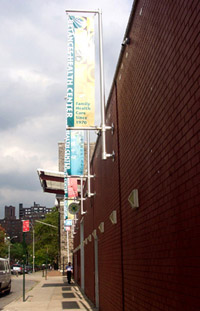 |
Despite such abuses – and even though some 400 million Medicaid claims were filed in New York State in 2004 -- the state health department managed to uncover only 37 cases of suspected fraud. Part of this reflects the lack of staff. About 50 state employees fight Medicaid fraud, down from more than 200 in the late 1980s. The series faulted both Governor George Pataki and Attorney General Elliot Spitzer for not doing more to fight abuses.
In response, Pataki announced a series of steps to fight fraud, including an overhaul of state agencies involved in the issue and creation of an independent inspector general’s office.
The governor’s announcement encountered some skepticism. “Shamed, embarrassed, caught with his pants down and lacking a good explanation for the loss of untold millions of taxpayer dollars, Governor Pataki said he was establishing an inspector general to battle a tsunami of fraud in New York’s $44.5 billion Medicaid program,” the Daily News said in an editorial. “Ooooh, an inspector general! That’ll throw a fright into the thieves who are robbing the program blind.”
“Certainly there’s a lot of waste in New York’s health care system,” said Laura Caruso of Medicaid Matters. “It’s not just Medicaid.” But, she cautioned that the state must take care in that, in cracking down on abuses, it “doesn’t mean putting people through the ringer to get the benefits they need.”
And Ward says that while fraud is a problem, “the real scandal is what’s legal.” As an example, he cited patients who know -- or who hire experts who know -- how to manipulate the system. Critics cite the case of a Long Island millionaire who managed to get Medicaid to pick up the tab for his wife’s nursing home care while he gave a huge contribution to a local college.
The story, reminiscent of Ronald Reagan’s welfare queens, may be apocryphal, but eldercare lawyers do advise people on how to rid themselves of their assets so they can qualify for Medicaid. How much such people cost the system is open to dispute. Soffel thinks cracking down on that would save only “a little money on the margins."
But many experts believe that any solution can only go so far to cut Medicaid costs in New York or anywhere else. Medicaid will be huge -– and costly -- as long as we have an ever-more costly health care system, in the words of a recent essay,"whose expenses will soon exceed $2 trillion -- more than the gross domestic product of Great Britain or France -- yet leaves 45 million Americans uninsured."
Photos by Jeannine Coppola
For More Information
ORGANIZATIONS AND WEB SITES
AARP Policy and Research
The policy arm of the American Association of Retired Persons
1199 SEIU
The Web site of the union that represents health care workers. It works to oppose cuts in Medicaid.
Greater New York Hospital Association
A trade association representing more than 250 not-for-profit hospitals and continuing care facilities, both voluntary and public, in the metropolitan area and the surrounding region.
Heritage Foundation
The page from a national conservative think tank includes links to research and articles on Medicaid.
Manhattan Institute
This page from the think tank includes links to many of its articles on Medicaid.
New York City Department of Health and Mental Hygiene
New York State Department of Health
Medicaid Matters New York
A coalition that advocates for Medicaid
United Hospital Fund
A nonprofit that works to improve health care in New York.
REPORTS AND ARTICLES
Finding a Better Way
A report by Medicaid Matters, a coalition that supports Medicaid, on ways to cut costs and improve care.
Low Income Consumers’ Experiences: Results from a Citywide Survey of Managed Care Consumers in Medicaid, Child Health Plus, and Family Health Plus (in pdf format)
A paper by the Community Service Society on a survey that highlighted the advantages and problems of moving Medicaid recipients into managed care.
Medicaid Watch 2005
A series of short papers by the Public Policy Institute, a business-oriented research group, on the costs of Medicaid in New York State and proposals to reduce those costs
The Myth of the Uncontrollables (in pdf format)
A report by the Citizens Budget Commission about how the city can pare some expenses it says it has no control over, including Medicaid.
New York Medicaid Fraud May Reach Into Billions
The New York Times article documenting widespread fraud in the state’s Medicaid system.
New York City's $4 Billion Medicaid Bill: What Is Driving the Rise in Costs?
A report by the Independent Budget Office
Understanding Medicare, Medigap and Medicaid
(AARP Magazine) A primer on how the system works.
Â
Mayor's Testimony Before the Financial Control Board On The City's Health
MAYOR BLOOMBERG TESTIFIES BEFORE THE NEW YORK STATE FINANCIAL CONTROL BOARD on July 28, 2005
Today, for the fourth time as mayor, I come before the members of this board, and the people of New York, to report on the fiscal health of our city.
The contrast between the harsh conditions that New York City faced the first time that I was here, and the far more encouraging ones that we enjoy today, is truly striking.
The combination of 9/11 and a steep national recession had taken a terrible toll on our city’s finances. During the final quarter of 2001, the city’s economy had lost nearly 100,000 jobs. Our tax revenues had plummeted, and the city faced its worst fiscal crisis in nearly 30 years.
But even in the bleakest times, our Administration remained confident that, if we made not just the hard decisions, but the right decisions, New York would recover, and that we would retain our status as the greatest place in the world to live, work, and do business.
Following 9/11, it was clear that City government was going to have to do more with less. In response, we have cut City tax levy spending by $3.6 billion. Yet today, the quality of services is better, our economic prospects are brighter, and the promise of opportunity for all in our city is greater than it was four years ago.
That was borne out in May, when Standard & Poor’s cited both our diverse economic base and our Administration’s sound fiscal management in upgrading the rating on New York City’s general obligation bonds from “A” to “A+.” That is the highest rating we have ever earned since they began evaluating New York G-O bonds 50 years ago. What a contrast to the era when this board was established—a period when New York City’s financial practices were so discredited that its bonds were unrated, and the city was shut out of the private credit market.
Clearly, our Administration has succeeded in improving the services that keep this a city where people want to live and businesses want to locate and expand. That is precisely what has happened. Today our city’s quality of life is improving… our economy is growing… and our finances are on a firm footing. While we continue to face serious challenges, if we stay on the course we have set, New York’s best days are still ahead.
Government’s first responsibility is public safety. In recent days, we have all appreciated how the New York City Police Department has risen to the challenge of providing the additional security on our streets and in our subways that the times demand. But even as our police department has dramatically increased all of its counter-terrorism and intelligence-gathering activities, it has also continued to drive crime down to levels not seen since the early 1960s. Crime today is nearly 20% lower than it was four years ago. Over that period, we have reduced crime in every borough, and in every category. We’ve had three consecutive years with fewer than 600 homicides, and this year we could even break the 500 mark.
Key indicators of other City services tell a similar success story. For the first time since World War II, the average life expectancy for New Yorkers is higher than it is for people in the rest of the nation. New Yorkers should continue to live longer and healthier lives because of our Administration’s successful efforts to help New Yorkers break the smoking habit. Today, there are 130,000 fewer smokers in New York than there were four years ago.
Under our Administration, our municipal hospitals and clinics have improved to the point that they are now recognized as being among the best public facilities in the nation. To build on those gains, and to ensure that all New Yorkers have access to top-quality health care, we’re investing more than $1 billion to modernize and expand Health and Hospitals Corporation facilities.
Our streets are cleaner than they have been in more than 30 years. The number of children in foster care is at a 17-year low. Because that means smaller caseloads, we’re able to reinvest the resulting savings in programs that strengthen troubled families. Over the last two years, we’ve reduced the number of people living in City homeless shelters by 12%, and the number of children in those shelters by 18%. As a result, we’re in the process of closing the largest family shelter in the city at the Carlton House Hotel in South Ozone Park.
Since 2002, we’ve moved 43,000 people off welfare. During that time, the number of New Yorkers receiving public assistance has fallen by 11%.
Over the last three and a half years, we’ve added 300 acres of parkland to the biggest and best city parks system in the nation. We have also launched the most ambitious affordable housing initiative that the city has seen in 20 years. We are on course to meeting our goal of preserving and creating affordable housing for more than 200,000 New Yorkers by the end of 2008.
And while our reform of the public schools—which I believe will be our Administration’s most lasting achievement—remains very much a work in progress, we’ve produced real results that show that we’re headed in the right direction.
This year, our 4th grade students achieved the greatest one-year gains ever on the State English Language Arts test. Students in grades 3, 5, 6, and 7 posted the highest scores and the biggest one-year gains on the citywide ELA and math tests since the City started giving those tests in 1999. Perhaps most heartening, our African American and Hispanic students made impressive gains in closing the achievement gap in our schools, with the biggest one-year test score gains and best performance levels ever.
The four-year high school graduation rate, while still too low, is the highest it has been since we started tracking it 20 years ago. The number of schools in danger of being closed as irreparable failures has been cut in half, and is at an all-time low.
Our Administration has matched these reforms with the highest levels of education funding in the city’s history. Since 2002, we’ve increased City spending on the public schools by $2.5 billion. We have also committed a record $6.5 billion in City funds to a school capital plan that will, when combined with the new classrooms we’ve already created, produce nearly 100,000 new classroom seats in all five boroughs.
In short, because we have made the operation of City government more efficient, we’ve been able to put the city’s finances in order, while also making the strategic public investments that have fueled New York’s dramatic economic recovery.
You can see the evidence of that recovery in virtually all of our key industries. Start with construction and real estate. Over the last few years, we have issued record numbers of new housing permits. In Queens alone, the number of residential permits issued last year was nearly five times greater than it was 10 years ago.
Citywide, the average price of housing has doubled since 1998. Our commercial occupancy rate is better than 90%, and is higher than in any other major city in the nation.
The financial services industry posted healthy profits of $13.7 billion during 2004.
There’s also good news in our all-important tourism industry, which generates $24 billion a year in business activity, and which supports the jobs of nearly 300,000 New Yorkers. This year, our city is on track to break last year’s record of 39.6 million visitors —in large part because the current forecast is that we will have an unprecedented 12 million visitors this summer. International tourism is also on the rise; last year, the number of visitors from overseas, who typically far outspend domestic tourists, grew by 10%--the first such increase since 2001.
The city’s overall economy is growing faster than the nation’s for the first time since 2001. Jobs figures released last week show that we gained 8,500 private sector jobs in June.
That puts us on course to meet or exceed the forecast that we will add 50,000 private sector jobs to the city’s economy this year. Wage earnings in the city are at levels not seen since before 9/11.
Unemployment citywide has now fallen to 5.5%. That’s lower than it was before 9/11. And for the last four months, it has remained below 6%, which is the first time that has happened since 2001.
As encouraging as these trends are, we’re not resting on our laurels. In order to ensure the city’s long-range prosperity, our Administration continues to pursue an aggressive strategy to diversify the economy and invest in all five boroughs.
Yesterday in Queens, I helped unveil the new American Airlines terminal at Kennedy Airport, financed by $1 billion in City I-D-A bonds. It will not only enhance JFK’s role as a major international gateway, but also complement our Administration’s efforts to create a new transportation-related business district in neighboring Jamaica.
In the Bronx, we’ll soon open the new $85 million Fulton Fish Market, the centerpiece of our strategy for bringing more food industry jobs to Hunts Point.
On Staten Island, we’ve begun making $66 million in infrastructure improvements in the Stapleton area that will turn the Homeport site into housing and open space and an economic engine for the borough.
We’re making $71 million of similar improvements to the area around the Brooklyn Navy Yard to support new tenants there, including Steiner Studios, the largest film and television soundstage on the East Coast. Film production continues to be a growing industry in our city. Over the last two years, film and television location shooting days in our city have increased by more than half. And in just six months time, our Administration’s targeted tax credits for television and film production have brought in $330 million worth of new business and provided jobs to 6,000 New Yorkers.
To encourage our manufacturing sector, we’re establishing industrial business zones across the city. And our rezonings of the Far West Side of Manhattan and Downtown Brooklyn have replaced long-outdated zoning regulations, and laid the foundation for private investment that will lead to major future commercial and residential expansion in those areas.
These and other policy initiatives and public investments will keep New York’s economy growing, and reinforce the city’s continued fiscal health.
The FCB’s staff report acknowledges the City’s strong fiscal position. As the report points out, City revenues have been so strong that the City was able to end Fiscal Year 2005 with a balanced budget while also pre-paying $3.5 billion in expenses for Fiscal Year 2006.
This permits us to balance next year’s budget while also enacting a range of much-needed and well-deserved tax relief measures for New Yorkers.
As it did last year, the $400 property tax rebate will repay those who made the greatest sacrifices in helping secure New York’s future. The Earned Income Tax Credit, included in the City budget for the second consecutive year, will also make a huge difference in the lives of hard-working New Yorkers who earn less than $36,000 per year.
The elimination of the City sales tax on clothing and footwear priced at less than $110, which the Governor signed into law on Monday, will help New Yorkers clothe their families. And virtually all of the money returned by these tax relief measures will be spent in our city, supporting local businesses, and creating local jobs.
Your staff report also makes note of the recent binding arbitration decision concerning the Patrolmen’s Benevolent Association. I want to call attention to the fact that the Public Employees Relations Board decision sets out productivity measures that the PBA must accept. That provides very important validation for our Administration’s position that raises for City workers must involve offsetting savings in the way that we do the people’s business. Weaving that principle into future collective bargaining agreements is fundamental to the city’s long-term fiscal health.
We remain hopeful that we will also reach a contract agreement with the United Federation of Teachers. And while we certainly will not negotiate that contract in public, I want to stress that it too must include productivity measures.
If the City were to compromise on that point in these negotiations, it would undermine our position with all of the other City unions, especially those that we are now having contract talks with.
Our school principals—the frontline managers of the school system—also must have greater flexibility and autonomy in doing their jobs. That will make a huge difference for the future of our schools and our students.
The future of our city also demands both fiscal prudence at the local level, and also urgent efforts at all levels of government to control the non-discretionary expenses borne by City taxpayers.
The current City budget illustrates this problem clearly. Between Fiscal Years 2005 and 2006, discretionary spending by City agencies is expected to grow by $139 million. But non-discretionary expenses, including pension and employee health benefit costs and the local share of Medicaid, will increase by $2.5 billion. Pension costs alone will account for $1.4 billion of that figure.
The continued growth of these non-discretionary costs is why we are projecting a $4.5 billion gap between City revenues and expenses in Fiscal Year 2007.
Action by State leaders to control these expenses is imperative. In the area of pension costs, for example, our rising expenditures are largely the product of pension “sweeteners,” enacted by the Legislature and passed on to the City as unfunded mandates that we increasingly cannot afford. This simply cannot go on.
Zero tolerance for inefficiency, waste, or fraud in the expenditure of any public dollars is also essential to balancing our budget in the out-years.
The recent reports of widespread fraud in the Medicaid program are highly troubling, and, if they are true, especially scandalous. This is not a “victimless crime”; far from it. The mounting costs of the Medicaid program translate into fewer dollars for our libraries, senior centers, and after-school programs, let alone such essential services as police and fire protection. The kind of cynical defrauding of the Medicaid program that we’ve been reading about is a crime against the people of New York that must be stopped, and its perpetrators must be punished.
Year after year, our Administration has joined the state’s county executives of both parties in asking Albany for Medicaid relief. The soft cap on local Medicaid expenditures enacted last year was a good beginning. But until a full audit of the program has been completed, and instances of fraud have been identified and eliminated, I believe the Legislature must refrain from any further enhancements to this program.
The City must also do its part to ensure fiscal prudence. In that vein, I’m glad to report that there is an emerging consensus among the members of the City Charter Revision Commission that the wise financial practices required by the State Financial Emergency Act should be made part of the Charter.
Our Administration will without reservation continue to apply those principles to overseeing the City’s finances. We look forward to continuing to work with the governor, the State and City comptrollers, State and local legislative leaders, and the FCB to safeguard our fiscal future.
And before closing, I would like to say, Governor, how much I appreciate everything you have done for our city and for our entire state, not just over the last three and a half years, but during your entire tenure.
In your remarks yesterday, you spoke from the heart about how the example of your parents taught you the intense satisfaction that comes from making life better for the whole community. Whatever path you choose to follow in the future, I hope that you find it rewarding, and that it gives you the kind of opportunities to serve others that you continue to exercise so well as governor of our state.
Â
